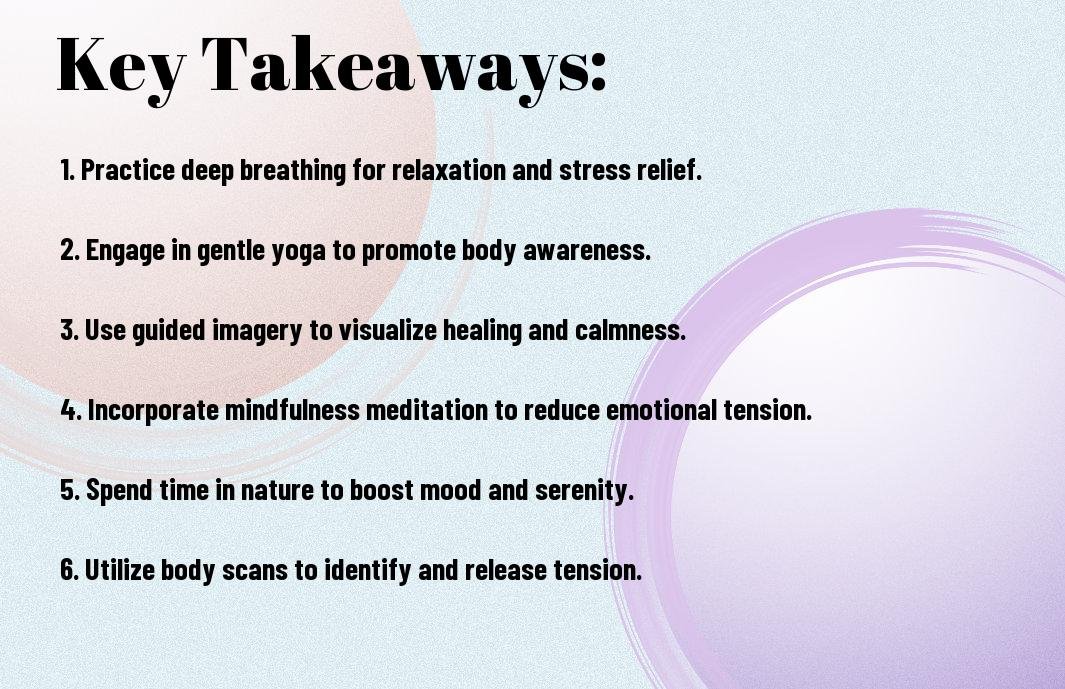As you explore ways to manage inflammation, you’ll discover that chronic stress can exacerbate the issue, leading to severe health consequences. Fortunately, practicing mindfulness can help mitigate this effect. You can harness the power of mindful meditation and deep breathing exercises to calm your mind and reduce inflammation. By incorporating these techniques into your daily routine, you’ll be better equipped to manage your body’s response to stress and promote overall well-being.
Key Takeaways:
- Practice Mindful Breathing to reduce stress and anxiety, which can contribute to inflammation in the body. This technique involves focusing on the breath and letting go of distracting thoughts.
- Incorporate Body Scan Meditation into your daily routine to release physical tension and promote relaxation. This can help alleviate inflammation by reducing muscle strain and improving overall well-being.
- Engage in Yoga to combine physical movement with mindfulness and breath awareness. This can help reduce inflammation by improving circulation, flexibility, and balance, while also calming the mind.
- Use Guided Imagery to visualize a peaceful and relaxing environment, which can help reduce stress and promote healing. This technique can be especially helpful for managing chronic pain and inflammation.
- Try Progressive Muscle Relaxation to release physical tension and promote deep relaxation. This technique involves systematically tensing and relaxing different muscle groups to reduce inflammation and improve overall physical and mental well-being.


Mindful Breathing Techniques
To reduce inflammation, you can try various mindful breathing techniques that promote relaxation and reduce stress. These techniques can help calm your mind and body, leading to a decrease in inflammation.
Diaphragmatic Breathing
Among the most effective breathing techniques is diaphragmatic breathing, which engages your diaphragm and promotes deep, relaxed breathing. You can practice this technique by placing one hand on your stomach and the other on your chest, taking slow breaths in through your nose and out through your mouth.
4-7-8 Breathing Method
Above all, the 4-7-8 breathing method is a powerful technique that can help reduce inflammation. You breathe in through your nose for a count of 4, hold your breath for a count of 7, and exhale through your mouth for a count of 8, promoting deep relaxation and reducing stress.
Breathing using the 4-7-8 method can have a profound impact on your body, as it can help slow down your heart rate, lower your blood pressure, and decrease inflammation. As you practice this technique, you may notice a significant reduction in your stress levels, leading to a Healthier and more balanced you, which is especially important for managing chronic inflammation and promoting overall well-being.

Meditation for Inflammation Reduction
Any mindfulness practice, including meditation, can help you manage inflammation by reducing stress and promoting relaxation. You can learn more about the benefits of mindfulness for pain management by visiting Mindfulness and Pain – Pain Management resources, which offer valuable insights into the connection between mindfulness and pain management.
Guided Meditation
Around guided meditation, you will find that it can be a great way to get started with mindfulness, as it involves following a gentle, soothing voice that guides you through the meditation process, helping you to focus your mind and calm your body.
Body Scan Meditation
Body scan meditation involves paying attention to different parts of your body, starting from your toes and moving up to the top of your head, noticing any sensations or feelings of tension, and releasing them as you breathe out.
Considering the benefits of body scan meditation, you will find that it can help you develop greater body awareness, reduce muscle tension, and promote deep relaxation. By practicing body scan meditation regularly, you can enhance your overall well-being and reduce inflammation in your body, leading to a healthier and happier you.
Physical Activities for Mindfulness
After incorporating mindfulness into your daily routine, you can explore physical activities that promote relaxation and reduce inflammation. You can try various exercises that calm your mind and soothe your body, leading to a healthier you.
Yoga for Inflammation
Physically demanding exercises can be counterproductive, but yoga is a gentle and effective way to ease inflammation. You can practice yoga to reduce stress and promote wellness in your body.
Tai Chi and Qigong
Similarly, yoga-like exercises such as Tai Chi and Qigong can help you achieve a balanced state of mind and body. You can practice these exercises to reduce inflammation and improve your overall health.
Hence, as you explore Tai Chi and Qigong, you will discover that these exercises combine slow movements with deep breathing techniques, helping you relax and reduce stress. By practicing Tai Chi and Qigong, you can experience a significant reduction in inflammation and improve your overall well-being, allowing you to live a healthier and more balanced life.
Grounding Techniques
Now, as you explore mindfulness techniques to ease inflammation, consider incorporating grounding methods into your routine. You can find a wealth of information on 32 Mindfulness Activities to Find Calm at Any Age to help you get started.
Walking Barefoot
Among the simplest grounding techniques is walking barefoot, which allows you to reconnect with the earth and reduce stress. By doing so, you can improve your mood and overall well-being.
Sensory Exploration
To further enhance your grounding experience, try sensory exploration, which involves paying attention to your senses. This technique can help you stay present and focused.
Walking through a natural setting, you can heighten your senses by noticing the sights, sounds, and smells around you. As you practice sensory exploration, you’ll become more aware of your surroundings and can better manage stress, leading to a reduction in inflammation. By incorporating these grounding techniques into your daily routine, you can improve your overall health and well-being.
Mindful Eating Practices
Despite the complexity of inflammation, you can ease its symptoms through mindful eating. By being more aware of your eating habits, you can reduce inflammation and improve your overall well-being.
Savoring Food
With each bite, you can cultivate a deeper connection with your food, paying attention to the flavors, textures, and aromas. This helps you eat more slowly and savor your food.
Healthy Nutrition
Savoring nutritious foods can have a positive impact on your health, as you focus on whole, unprocessed foods like fruits, vegetables, and whole grains. You can reduce inflammation by avoiding sugary and fried foods.
Due to the benefits of healthy nutrition, you can experience improved digestion, reduced inflammation, and a stronger immune system. By making informed choices about your diet, you can take control of your health and minimize the risk of chronic diseases. As you adopt these mindful eating practices, you will become more aware of your body’s needs and responses, allowing you to make the best choices for your overall well-being.

Stress Management through Mindfulness
Not surprisingly, mindfulness techniques can help you manage stress, which is a significant contributor to inflammation. You can learn more about mindfulness exercises and how they can help you reduce stress and anxiety, leading to a healthier life.
Journaling
Around the time you start practicing mindfulness, you may find it helpful to start journaling, which can help you process your thoughts and emotions, leading to a more balanced life.
Progressive Muscle Relaxation
Around your daily routine, you can practice progressive muscle relaxation, which involves tensing and relaxing different muscle groups to release tension and promote relaxation.
Another key aspect of progressive muscle relaxation is its ability to help you become more aware of your body and reduce stress in a healthy way, which can lead to lower inflammation levels and a reduced risk of chronic diseases, allowing you to take control of your overall well-being.
Final Words
Summing up, you now have various ideas for mindfulness techniques to ease inflammation. You can incorporate these methods into your daily routine to reduce stress and promote overall well-being. By practicing mindfulness, you will become more aware of your body and better equipped to manage inflammation, leading to a healthier you. Your commitment to mindfulness will have a positive impact on your physical and mental health, allowing you to thrive.
FAQ
Q: What is the relationship between mindfulness and inflammation reduction?
A: Mindfulness techniques have been shown to have a positive impact on reducing inflammation in the body. By practicing mindfulness, individuals can reduce stress and anxiety, which are known contributors to inflammation. Regular mindfulness practice can help to decrease the production of pro-inflammatory cytokines, leading to a decrease in inflammation and promoting overall well-being.
Q: What are some effective mindfulness techniques for easing inflammation?
A: Some effective mindfulness techniques for easing inflammation include deep breathing exercises, progressive muscle relaxation, and guided meditation. These techniques can help to reduce stress and promote relaxation, leading to a decrease in inflammation. Additionally, practices such as yoga and tai chi, which combine physical movement with mindfulness, can also be beneficial in reducing inflammation.
Q: How can I incorporate mindfulness into my daily routine to help ease inflammation?
A: Incorporating mindfulness into your daily routine can be simple and easy. Start by setting aside a few minutes each day to practice deep breathing exercises or guided meditation. You can also try incorporating mindfulness into your daily activities, such as eating or walking, by paying attention to your senses and the present moment. Additionally, consider starting or ending your day with a mindfulness practice, such as a short meditation or yoga routine, to help set a positive tone and reduce inflammation.
Q: Can mindfulness techniques be used in conjunction with other therapies to ease inflammation?
A: Yes, mindfulness techniques can be used in conjunction with other therapies to ease inflammation. In fact, many healthcare providers are now incorporating mindfulness-based therapies into treatment plans for conditions such as arthritis, fibromyalgia, and other inflammatory diseases. Mindfulness can be used in combination with medication, physical therapy, and other treatments to enhance their effectiveness and promote overall well-being.
Q: How long does it take to see the benefits of mindfulness on inflammation reduction?
A: The benefits of mindfulness on inflammation reduction can be seen in as little as a few weeks of regular practice. However, the extent of the benefits can vary depending on the individual and the consistency of their practice. With regular mindfulness practice, individuals can experience a significant reduction in inflammation and improvements in overall health and well-being over time. It is vital to be patient and consistent with your practice, as the benefits of mindfulness are often cumulative and can take time to develop.



